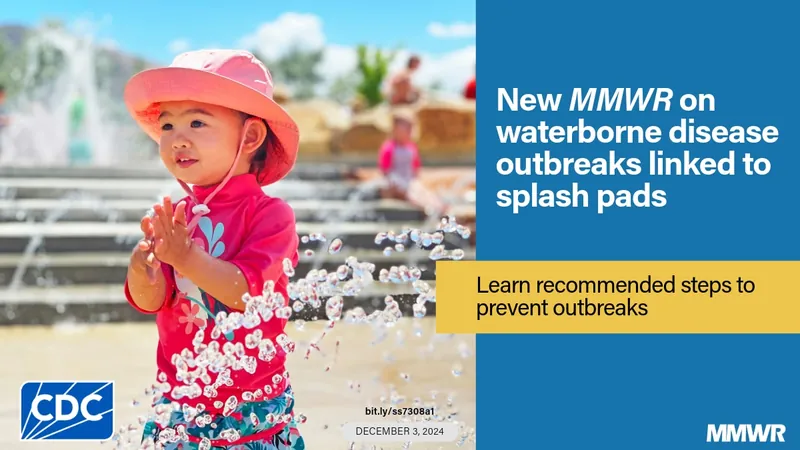
Alarming Rise of Waterborne Disease Outbreaks Linked to Splash Pads in the U.S. — 1997-2022
2024-12-06
Author: Ying
Introduction
Splash pads, popular among families and children, also known as water playgrounds or interactive fountains, have gained massive popularity since their debut in the 1990s. Designed primarily for fun and to minimize drowning risks by avoiding standing water, these wet play areas have proven to be anything but harmless. Despite their seemingly safe design, splash pads have been increasingly associated with outbreaks of waterborne diseases, raising significant public health concerns across the United States.
Between 1997 and 2022, public health officials documented a staggering 60 outbreaks connected with splash pads in 23 states and Puerto Rico. Overall, these outbreaks resulted in over 10,000 reported cases of illness, along with numerous hospitalizations, sparking urgent calls for improved safety measures.
The Problem with Splash Pads
Splash pads typically work in one of two ways: they either recirculate water, filtering and disinfecting it after it has been used, or they rely on single-pass systems where water is used once and then drained away. Unfortunately, many splash pads may fall under limited public health regulations due to their unique design, leaving them vulnerable to outbreaks.
Public health initiatives have struggled to keep up with the proliferation of splash pads. Prior to 2000, only 13 states implemented regulations concerning splash pads. Recently, various states such as Oregon have moved to establish health regulations, often in response to contagions stemming from these aquatic devices.
Epidemiological Insights
Data collected from the Centers for Disease Control and Prevention (CDC) sheds light on the reasons behind splash pad outbreaks. Laboratory analysis revealed that the leading culprit of these waterborne diseases is the parasite Cryptosporidium, which was responsible for about 67% of reported outbreaks. This parasite poses a significant threat, particularly to young children, who are often the primary users of splash pads. The continued occurrence of such outbreaks suggests a pressing need for better maintenance and hygiene practices to protect vulnerable populations.
The situation is exacerbated by a lack of consistent monitoring and control measures at splash pad facilities. The CDC recommends maintaining adequate levels of chlorine to inhibit pathogen transmission; however, many facilities struggle with maintaining this standard, often leading to rapid depletion of effective disinfectant levels.
Seasonal Trends of Outbreaks
Surprisingly, nearly all reported outbreaks occurred during the warmer months from May to August, when splash pad usage spikes, especially among children. Public parks and community settings reported the highest incidence of these outbreaks, underscoring the critical need for stricter health regulations and community awareness on the matter.
A Call for Action
To combat these rising threats, the CDC has introduced a revised Model Aquatic Health Code (MAHC) that outlines specific recommendations for the construction, design, operation, and maintenance of splash pads. These recommendations include measures such as installing secondary disinfection systems capable of inactivating waterborne pathogens such as Cryptosporidium, thereby significantly reducing the chances of an outbreak.
Community education is another essential step toward preventing disease outbreaks connected to splash pads. Parents need to be informed about safe practices, such as ensuring their children are healthy before using these facilities, the importance of proper hygiene, and the dangers associated with splash pads in general.
Conclusion
The findings from the CDC highlight a growing public health crisis associated with splash pads, particularly among children. With the imminent threat of waterborne diseases linked to these recreational venues, stakeholders, including parents, public health officials, and facility managers, must come together to implement stringent safety protocols. Without decisive action, the fun of splash pads could continue to come at a grave cost to public health, sending a wake-up call to communities nationwide.
Stay Informed!
If you care about your family's health and want to know more about keeping your community safe from outbreaks, follow updates from public health officials and advocate for better health standards at neighborhood splash pads!

 Brasil (PT)
Brasil (PT)
 Canada (EN)
Canada (EN)
 Chile (ES)
Chile (ES)
 Česko (CS)
Česko (CS)
 대한민국 (KO)
대한민국 (KO)
 España (ES)
España (ES)
 France (FR)
France (FR)
 Hong Kong (EN)
Hong Kong (EN)
 Italia (IT)
Italia (IT)
 日本 (JA)
日本 (JA)
 Magyarország (HU)
Magyarország (HU)
 Norge (NO)
Norge (NO)
 Polska (PL)
Polska (PL)
 Schweiz (DE)
Schweiz (DE)
 Singapore (EN)
Singapore (EN)
 Sverige (SV)
Sverige (SV)
 Suomi (FI)
Suomi (FI)
 Türkiye (TR)
Türkiye (TR)
 الإمارات العربية المتحدة (AR)
الإمارات العربية المتحدة (AR)